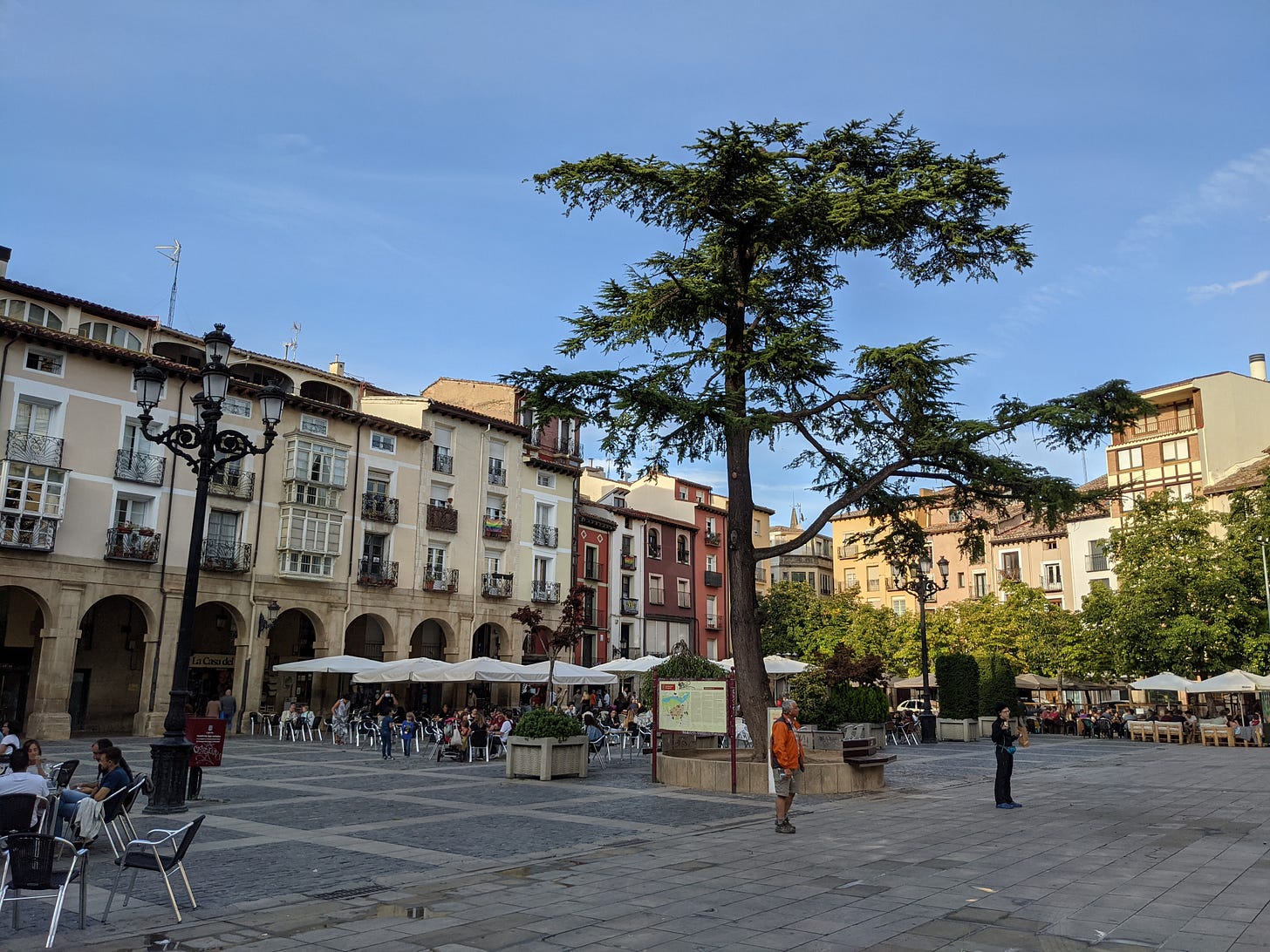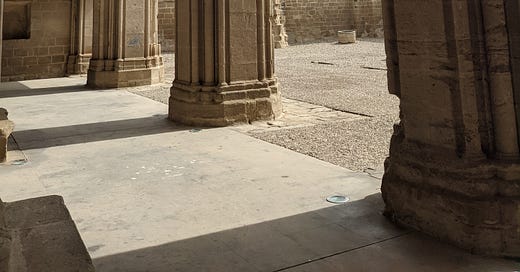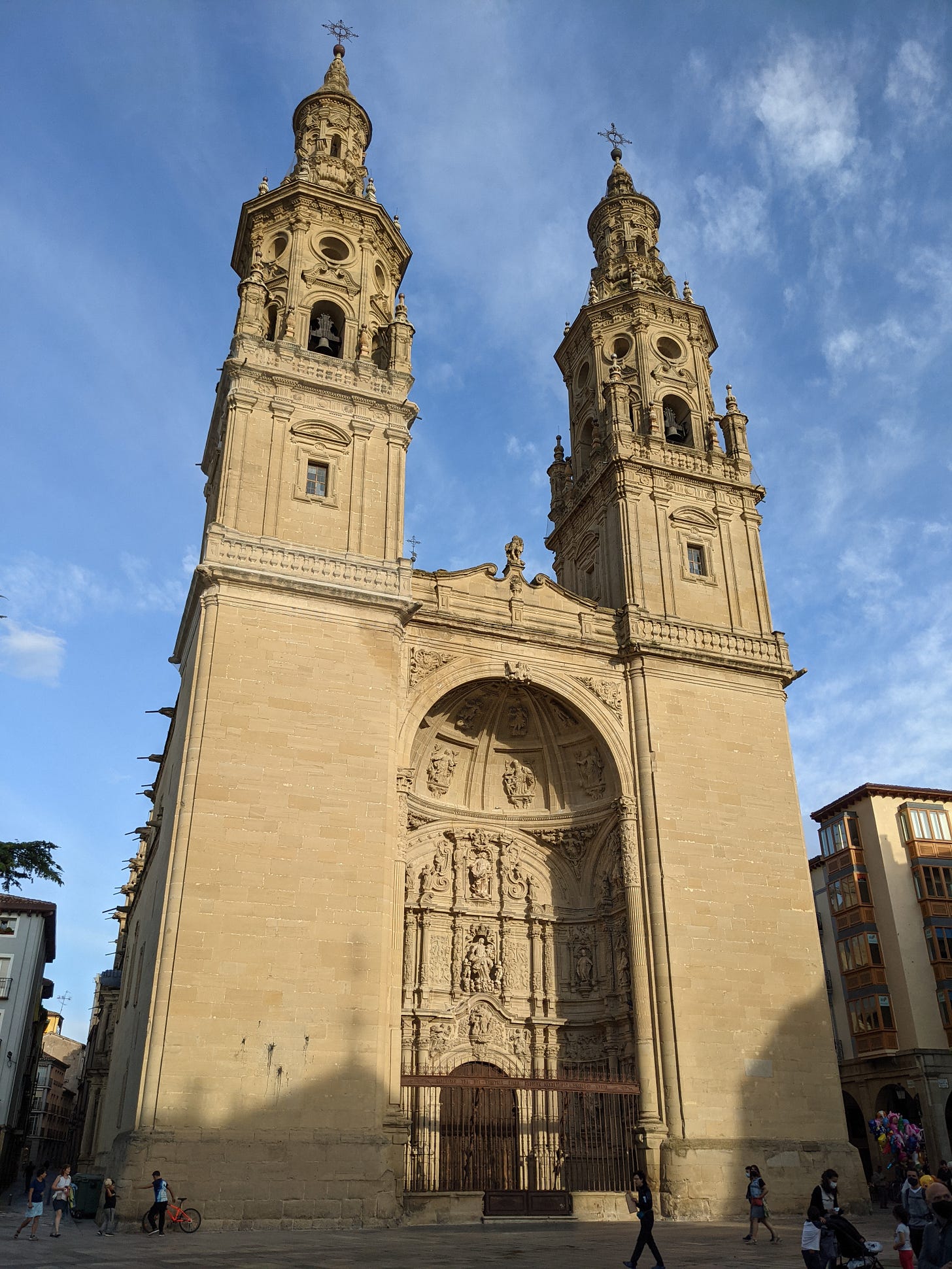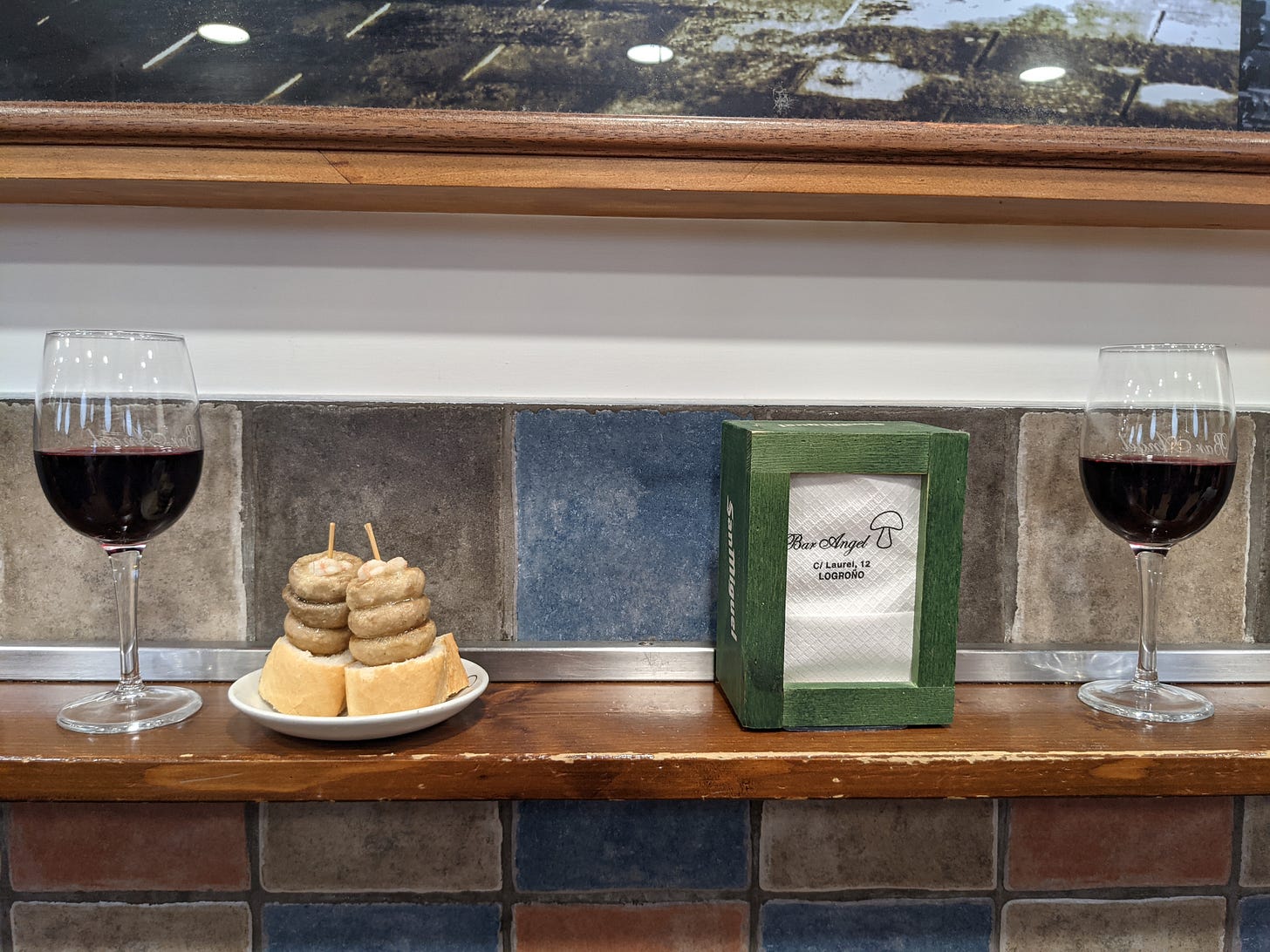Camino de Santiago Day 7: Torres del Rio to Logroño
Walking and talking, visiting some old ruins, and a return to The City in time for a wine festival: a place that offers "cathedrals, and drinking"
If you would like to follow me on my journey on the Camino de Santiago, then sign up now for regular updates.
I bump into Ran on the way out of Torres del Rio – a friend from America via Costa Rica, we’d met in Pamplona and ended up spending more and more time walking and talking on the trail as the days went on.
I don’t remember much of the walk – it was all talk to be honest. It made the whole thing a lot easier to be honest, as if the conversation by our chats was fueling our bodies and legs.
We bumped into Kathrine along the way – our German friend, the one who’d bought my credential on Day 0. It was nice to be slowly forming connections that facilitated authentic connection, rather than simply pleasant exchange of information. In a sense I think I feared that the Camino – or any event in my life – would end up a series of ‘pleasant conversations’ and nothing more. I could think of no worse fate than that, to be honest.
We walked and talked ourselves all the way to Logroño, after an enjoyable lunch by the church in Viana, whose main dining street sits on the Camino such that there’s a constant stream of pilgrims and locals alike as you sit to eat, on tables and chairs either side of the Camino way.
After lunch we explore the exquisite ruins of an old church. Remembering it now reminds me of when English writer Geoff Dyer took a trip to the ruins of the ancient Roman city of Leptis Magna in Libya some years ago. Well, it reminds me of the account he wrote of it, I don’t remember the trip itself.
Such places give the impression, he writes, that they:
“only really got going when (they) fell into ruin”
– many ancient ruins are not defined by what they were, but become all the more glorious for the state they are in now – they would have been average when they were fully intact, and it is their decline over a span of centuries that defines them.
“Ruins do not make you wish you had seen them earlier”, like some sites which speak in the present of their former, better selves or the eras in which their environment was at its peak.
“Ruins are what is left when history has moved on.”
In any case, it’s the sort of place - just at the end of the street - that elicits genuine gasps and smiles from us as we enter the door to explore it.
Ran tells us a touching story from home as we leave.
We walk and we talk
In Logroño I see a big cathedral, which unlike the ruins is most definitely defined by what it is now – it’s enormous, and grand in the European rather than Irish sense. I try to go in the side door towards the organ music but am met with a stream of people coming the opposite direction, until I realise I’m trying to go the wrong way into the wrong end of mass – it’s over.
The also-rather-grand Rio Ebro greets us at the entrance to the city, though it seems to be flowing in the wrong direction; towards the Mediterranean Sea, a considerable distance away, rather than to Santiago, which is also a considerable distance away. We have just crossed the first internal border within Spain – having spent most of the week walking through the autonomous region of Navarre, which is historically part of the Basque country – though separate to the autonomous community of the Pays Basque, I believe (I’m still always teetering on the edge of being completely wrong about this) – we have just entered the region of La Rioja: Spain’s biggest wine producing region.
Well, I presume it’s the biggest – whether it is or not, it’s the wine-producing region that I’m currently standing in, which I believe is far more important than some arbitrary figure of its relative scale.
I could never drink it all, I don’t think.
If you’re enjoying this and think others will enjoy reading about my journey on the Camino, then why not share it?
I realise I’ve finished my first week of walking. It’s an occasion that feels like it should be at least mentally noted, if not discussed with others or marked in some other way, whether with a few drinks, a celebratory meal, a day of rest or a phone call home.
I’ll decide again in the morning whether to rest or not, my ankle is getting quite inflamed, and making a strange creaking sound like an old floorboard; I fear more its fragility than any pain it might cause, I’m used to the pain but I’d be gutted if I’d to stop
There are murals on walls urging us to keep going, and a river which rushes over waterfalls and rock pools
I bathe my feet in the foot pool at the albergue, and walk around without boots on. What else can you do in a city, only walk around some more? Another 5km, or more, though there are more places to stop and eat and drink.
It just so happens that we’ve made it into town and province in time for the final night of the region’s annual wine festival. I’m not sure what it entails, but I feel it would be worth trying to catch some sort of revelry associated with it, if only for the purposes of cultural appreciation and integration.
I enjoy being back in the hum of people of a city but the place doesn’t grab me quite in the same as Pamplona did. For some reason I think a lot about pickpockets, and keep checking I have everything on my person. Logroño feels a bit less homely and inviting than Pamplona, though maybe it’s just personal preference – it seems like every city has its fans and indifferents on the Camino, each one speaking to one person or another in different ways.
Some see the cities on the Camino as obstacles to be navigated; some see them as sights to be ticked off the list; some see them as psychological milestones, places which deliminate a period of walking of days or weeks, and mark transitions between stages of the trip as a whole; some see them as places to stop and rest; and some see them as the antithesis of the ‘real’ Camino, of the small towns and villages and churches that make up the ‘real’ Spain, as they snark about all the rednecks living in equivalent rural parts of their home countries, championing their city as the only bastion of sanity in a world of stubborn conservation, while dismissing Pamplona, Burgos, Leon, and others as “just another city”.

But I’m not convinced.
What were the cities for me?
My Basque friend had told me Pamplona is nice “if you like cathedrals, drinking…”
Logroño, too, has a nice cathedral, and is good if you like going out drinking.
In Burgos, “there’s a nice cathedral, and some nice bars.”
Léon also: “a really nice cathedral… and drinking.”
So cities are for drinking in, and for going to mass.
Though really we should take a ‘cathedral’, I suppose, to be shorthand for ‘culture, architecture and history’, and ‘drinking’ as short for ‘eating and drinking’, if we wanted to pay Spanish culture and cities their fair due. And in this sense, this is exactly what they offer, and if that is all they do offer, then they have done a very good job indeed.
It’s beginning to dawn on me that there’s far more potential for ‘craic’ on the Camino that I’d been expecting. There are bars every few kilometres, after all, and there’s much enthusiastic travellers energy around. Not alone the drinking and bars, the whole thing is a lot less… serious… than I was expecting – myself included.
Maybe this is what happens when everyone opens up after the first few days of walking. Maybe everyone just wants to have fun, after all.
I’m starting to get the feeling that pilgrims enter the cities along the way as if sailor’s on shore leave, all pent up excitement from days spent all at sea on the open road. I wonder if many ever end up in hospital, or in jail. It is inevitable, really. Does indulging in the entertainment of a city diminish one’s spiritual practice? Jesus did turn water into wine, after all. It’s something that I’d begun to start thinking about, and a question that would be with me more and more until I reached Santiago.
It is impossible to deny, however, regardless of one’s state of intoxication or not – that in general – Spanish cities are gorgeous. There is a hum of life here again, and after walking some laps down pretty streets I meet a friend and go out for food and drinks at Calle Laurel, a narrow alleyway flanked with fantastic restaurants. The custom is to get a drink and a bite-sized meal at one, and then wander onto the next, an implied spring in your step as you hop out the door and into the next one, perhaps bumping into friends or strangers along the way, no doubt swinging from a lamppost and with your cap in your outstretched arm after you’ve had three or four.
Neat little dishes of rice and a perfectly-cooked egg; salted baked potatoes with injections of picante sauce; morcilla (black pudding) and sausage and bacon; and my favourite: a place that only serves garlic mushrooms, stacked three high and with a prawn on top, served on a slice of bread.
I gaze in awe at the hundreds of mushrooms stacked on the grill, cheap but delicious glass of wine in my hand, and wonder why our late-night food offerings at home can’t just be that little bit more nutritious, or tasty in a less overtly diabolically unhealthy and sinful kind of way.
We hop from this delightful shop to another; where the waitress is intensely rude for a place with such terrible photos of terrible food on its menu.
“I think she needs to walk to Viana and back”.
We have already come to learn of the health-imbuing properties of the Camino, physical, mental or whatever it is you need. The lady amuses more than bothers us, perhaps the result of our own walking practice, and we sit on a step drinking in the city and the drunken crowds.
I practice my Spanish by ordering different types of wine,
we walk and we talk.
If you’ve done the Camino, are thinking of doing it, or are just interested in discussing the Camino or travel in general - then please leave a comment. I’d love to hear from you.







